Engineering function
Returns the modified Bessel function, which is equivalent to the Bessel function evaluated for purely imaginary arguments.
syntax
BESSELI(X, N)
X
Required. The value at which to evaluate the function.
N
Required. The order of the Bessel function. If n is not an integer, it is truncated.

Besselj function
Returns the Bessel function.
syntax
BESSELJ(X, N)
X
Required. The value at which to evaluate the function.
N
Required. The order of the Bessel function. If n is not an integer, it is truncated.
Besselk function
Returns the modified Bessel function, which is equivalent to the Bessel functions evaluated for purely imaginary arguments.
syntax
BESSELK(X, N)
X
Required. The value at which to evaluate the function.
N
Required. The order of the function. If n is not an integer, it is truncated.
Besely function
Returns the Bessel function, which is also called the Weber function or the Neumann function.
syntax
BESSELY(X, N)
X
Required. The value at which to evaluate the function.
N
Required. The order of the function. If n is not an integer, it is truncated.
Bin2dec function
Converts a binary number to decimal.
syntax
BIN2DEC(number)
Number
Required. The binary number you want to convert. Number cannot contain more than 10 characters (10 bits). The most significant bit of number is the sign bit. The remaining 9 bits are magnitude bits. Negative numbers are represented using two's-complement notation.
Bin2hex function
Converts a binary number to hexadecimal.
syntax
BIN2HEX(number, [places])
Number
Required. The binary number you want to convert. Number cannot contain more than 10 characters (10 bits). The most significant bit of number is the sign bit. The remaining 9 bits are magnitude bits. Negative numbers are represented using two's-complement notation.
Places
Optional. The number of characters to use. If places is omitted, BIN2HEX uses the minimum number of characters necessary. Places is useful for padding the return value with leading 0s (zeros).
Bin2oct function
Converts a binary number to octal.
syntax
BIN2OCT(number, [places])
Number
Required. The binary number you want to convert. Number cannot contain more than 10 characters (10 bits). The most significant bit of number is the sign bit. The remaining 9 bits are magnitude bits. Negative numbers are represented using two's-complement notation.
Places
Optional. The number of characters to use. If places is omitted, BIN2OCT uses the minimum number of characters necessary. Places is useful for padding the return value with leading 0s (zeros).
Complex function
Converts real and imaginary coefficients into a complex number of the form x + yi or x + yj.
syntax
COMPLEX(real_num, i_num, [suffix])
Real_num
Required. The real coefficient of the complex number.
I_num
Required. The imaginary coefficient of the complex number.
Suffix
Optional. The suffix for the imaginary component of the complex number. If omitted, suffix is assumed to be "i".
Convert function
Converts a number from one measurement system to another. For example, CONVERT can translate a table of distances in miles to a table of distances in kilometers.
syntax
CONVERT(number,from_unit,to_unit)
Number
is the value in from_units to convert.
From_unit
is the units for number.
To_unit
is the units for the result. CONVERT accepts the following text values (in quotation marks) for from_unit and to_unit.
Dec2bin function
Converts a decimal number to binary.
syntax
DEC2BIN(number, [places])
Number
Required. The decimal integer you want to convert. If number is negative, valid place values are ignored and DEC2BIN returns a 10-character (10-bit) binary number in which the most significant bit is the sign bit. The remaining 9 bits are magnitude bits. Negative numbers are represented using two's-complement notation.
Places
Optional. The number of characters to use. If places is omitted, DEC2BIN uses the minimum number of characters necessary. Places is useful for padding the return value with leading 0s (zeros).
Dec2hex function
Converts a decimal number to hexadecimal.
syntax
DEC2HEX(number, [places])
Number
Required. The decimal integer you want to convert. If number is negative, places is ignored and DEC2HEX returns a 10-character (40-bit) hexadecimal number in which the most significant bit is the sign bit. The remaining 39 bits are magnitude bits. Negative numbers are represented using two's-complement notation.
Places
Optional. The number of characters to use. If places is omitted, DEC2HEX uses the minimum number of characters necessary. Places is useful for padding the return value with leading 0s (zeros).
Dec2oct function
Converts a decimal number to octal.
syntax
DEC2OCT(number, [places])
Number
Required. The decimal integer you want to convert. If number is negative, places is ignored and DEC2OCT returns a 10-character (30-bit) octal number in which the most significant bit is the sign bit. The remaining 29 bits are magnitude bits. Negative numbers are represented using two's-complement notation.
Places
Optional. The number of characters to use. If places is omitted, DEC2OCT uses the minimum number of characters necessary. Places is useful for padding the return value with leading 0s (zeros).
Delta function
Tests whether two values are equal. Returns 1 if number1 = number2; returns 0 otherwise. Use this function to filter a set of values. For example, by summing several DELTA functions you calculate the count of equal pairs. This function is also known as the Kronecker Delta function.
syntax
DELTA(number1, [number2])
Number1
Required. The first number.
Number2
Optional. The second number. If omitted, number2 is assumed to be zero.
Erf function
Returns the error function integrated between lower_limit and upper_limit.
syntax
ERF(lower_limit,[upper_limit])
Lower_limit
Required. The lower bound for integrating ERF.
Upper_limit
Optional. The upper bound for integrating ERF. If omitted, ERF integrates between zero and lower_limit.
Erf.precise function
Returns the error function.
syntax
ERF.PRECISE(x)
X
Required. The lower bound for integrating ERF.PRECISE.
Gestep function
Returns 1 if number ≥ step; returns 0 (zero) otherwise. Use this function to filter a set of values. For example, by summing several GESTEP functions you calculate the count of values that exceed a threshold.
syntax
GESTEP(number, [step])
Number
Required. The value to test against step.
Step
Optional. The threshold value. If you omit a value for step, GESTEP uses zero.
Hex2bin function
Converts a hexadecimal number to binary.
syntax
HEX2BIN(number, [places])
Number
Required. The hexadecimal number you want to convert. Number cannot contain more than 10 characters. The most significant bit of number is the sign bit (40th bit from the right). The remaining 9 bits are magnitude bits. Negative numbers are represented using two's-complement notation.
Places
Optional. The number of characters to use. If places is omitted, HEX2BIN uses the minimum number of characters necessary. Places is useful for padding the return value with leading 0s (zeros).
Hex2dec function
Converts a hexadecimal number to decimal.
syntax
HEX2DEC(number)
Number
Required. The hexadecimal number you want to convert. Number cannot contain more than 10 characters (40 bits). The most significant bit of number is the sign bit. The remaining 39 bits are magnitude bits. Negative numbers are represented using two's-complement notation.
Hex2oct function
Converts a hexadecimal number to octal.
syntax
HEX2OCT(number, [places])
Number
Required. The hexadecimal number you want to convert. Number cannot contain more than 10 characters. The most significant bit of number is the sign bit. The remaining 39 bits are magnitude bits. Negative numbers are represented using two's-complement notation.
Places
Optional. The number of characters to use. If places is omitted, HEX2OCT uses the minimum number of characters necessary. Places is useful for padding the return value with leading 0s (zeros).
Imabs function
Returns the absolute value (modulus) of a complex number in x + yi or x + yj text format.
syntax
IMABS(inumber)
Inumber
Required. A complex number for which you want the absolute value.
Imaginary function
Returns the imaginary coefficient of a complex number in x + yi or x + yj text format.
syntax
IMAGINARY(inumber)
Inumber
Required. A complex number for which you want the imaginary coefficient.
Imconjugate function
Returns the complex conjugate of a complex number in x + yi or x + yj text format.
syntax
IMCONJUGATE(inumber)
Inumber
Required. A complex number for which you want the conjugate.
Imcos function
Returns the cosine of a complex number in x + yi or x + yj text format.
syntax
IMCOS(inumber)
Inumber
Required. A complex number for which you want the cosine.
Imdiv function
Returns the quotient of two complex numbers in x + yi or x + yj text format.
syntax
IMDIV(inumber1, inumber2)
Inumber1
Required. The complex numerator or dividend.
Inumber2
Required. The complex denominator or divisor.
Imexp function
Returns the exponential of a complex number in x + yi or x + yj text format.
syntax
IMEXP(inumber)
Inumber
Required. A complex number for which you want the exponential.
Imln function
Returns the natural logarithm of a complex number in x + yi or x + yj text format.
syntax
IMLN(inumber)
Inumber
Required. A complex number for which you want the natural logarithm.
Imlog10 function
Returns the common logarithm (base 10) of a complex number in x + yi or x + yj text format.
syntax
IMLOG10(inumber)
Inumber
Required. A complex number for which you want the common logarithm.
Imlog2 function
Returns the base-2 logarithm of a complex number in x + yi or x + yj text format.
syntax
Inumber
Required. A complex number for which you want the base-2 logarithm.
Impower function
Returns a complex number in x + yi or x + yj text format raised to a power.
syntax
IMPOWER(inumber, number)
Inumber
Required. A complex number you want to raise to a power.
Number
Required. The power to which you want to raise the complex number.
Improduct function
Returns the product of 1 to 255 complex numbers in x + yi or x + yj text format.
syntax
IMPRODUCT(inumber1, [inumber2], ...)
Inumber1, [inumber2], …
Inumber1 is required, subsequent inumbers are not. 1 to 255 complex numbers to multiply.
Imreal function
Returns the real coefficient of a complex number in x + yi or x + yj text format.
syntax
IMREAL(inumber)
Inumber
Required. A complex number for which you want the real coefficient.
Imsin function
Returns the sine of a complex number in x + yi or x + yj text format.
syntax
IMSIN(inumber)
Inumber
Required. A complex number for which you want the sine.
Imsqrt function
Returns the square root of a complex number in x + yi or x + yj text format.
syntax
IMSQRT(inumber)
Inumber
Required. A complex number for which you want the square root.
Imsub function
Returns the difference of two complex numbers in x + yi or x + yj text format.
If you just want to subtract two numbers that are not complex, see subtract numbers.
syntax
IMSUB(inumber1, inumber2)
Inumber1
Required. The complex number from which to subtract inumber2.
Inumber2
Required. The complex number to subtract from inumber1.
Imsum function
Returns the sum of two or more complex numbers in x + yi or x + yj text format.
syntax
IMSUM(inumber1, [inumber2], ...)
Inumber1, [inumber2], ...
Inumber1 is required, subsequent numbers are not. 1 to 255 complex numbers to add.
Oct2bin function
Converts an octal number to binary.
syntax
OCT2BIN(number, [places])
Number
Required. The octal number you want to convert. Number may not contain more than 10 characters. The most significant bit of number is the sign bit. The remaining 29 bits are magnitude bits. Negative numbers are represented using two's-complement notation.
Places
Optional. The number of characters to use. If places is omitted, OCT2BIN uses the minimum number of characters necessary. Places is useful for padding the return value with leading 0s (zeros).
Oct2dec function
Converts an octal number to decimal.
syntax
OCT2DEC(number)
Number
Required. The octal number you want to convert. Number may not contain more than 10 octal characters (30 bits). The most significant bit of number is the sign bit. The remaining 29 bits are magnitude bits. Negative numbers are represented using two's-complement notation.
Oct2hex function
Converts an octal number to hexadecimal.
syntax
OCT2HEX(number, [places])
Number
Required. The octal number you want to convert. Number may not contain more than 10 octal characters (30 bits). The most significant bit of number is the sign bit. The remaining 29 bits are magnitude bits. Negative numbers are represented using two's-complement notation.
Places
Optional. The number of characters to use. If places is omitted, OCT2HEX uses the minimum number of characters necessary. Places is useful for padding the return value with leading 0s (zeros).
















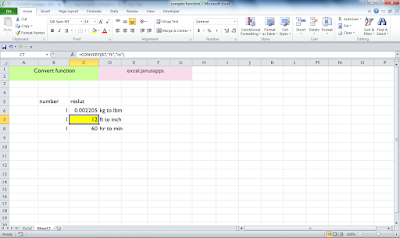











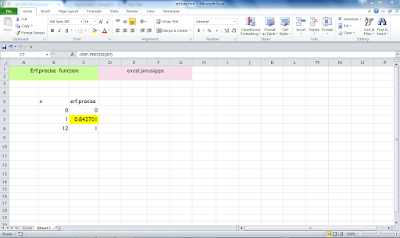


















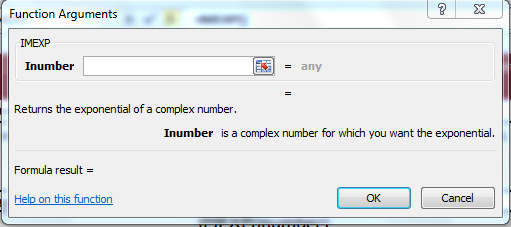


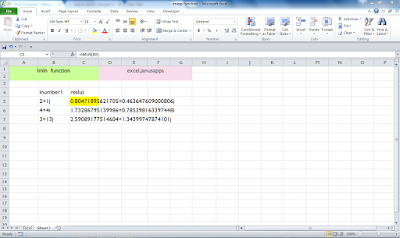



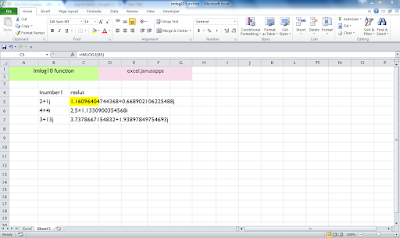






















No comments:
Post a Comment